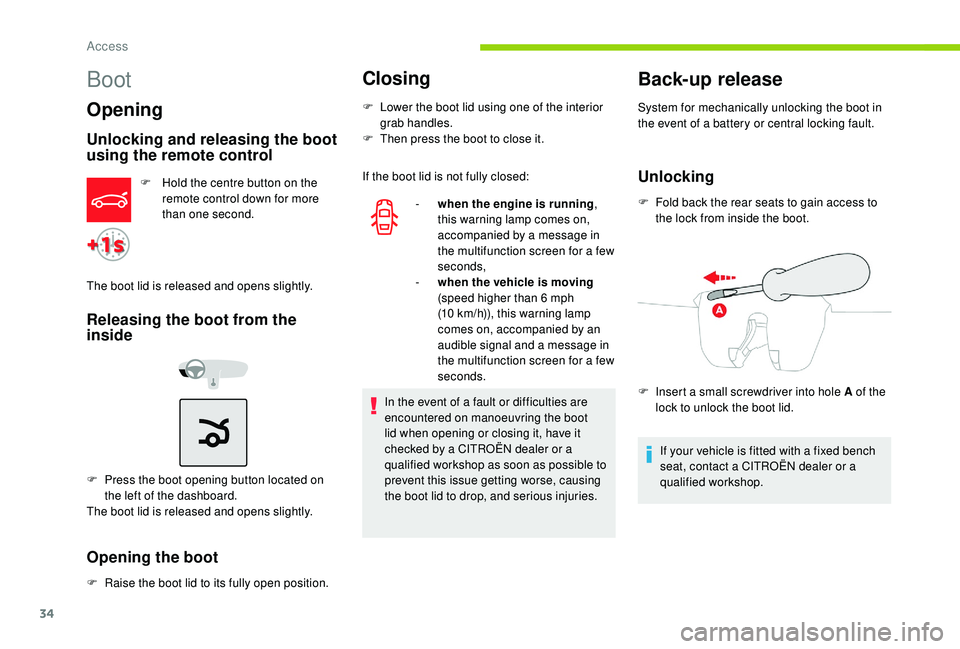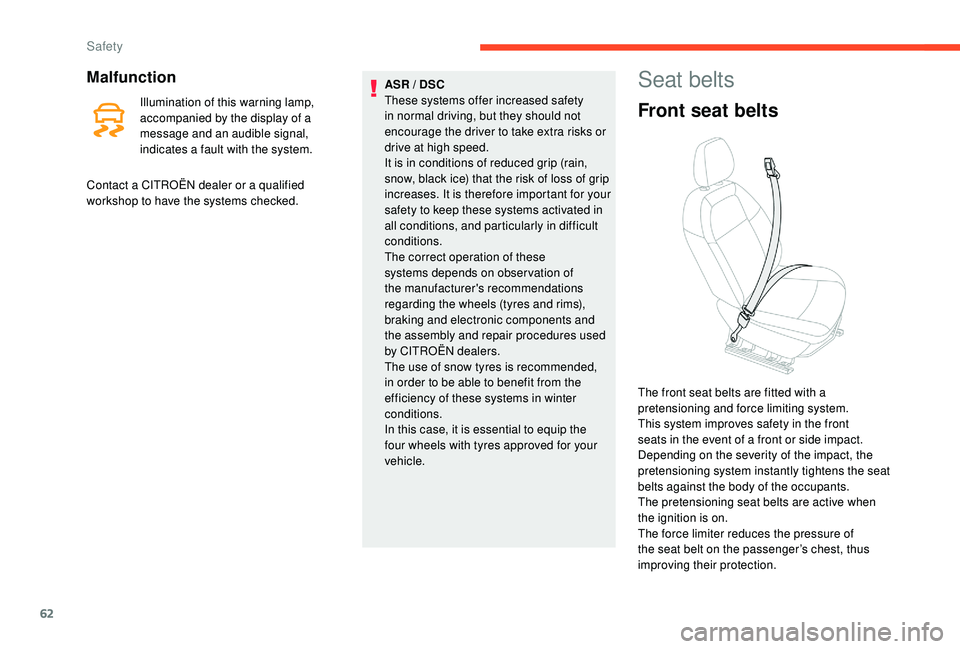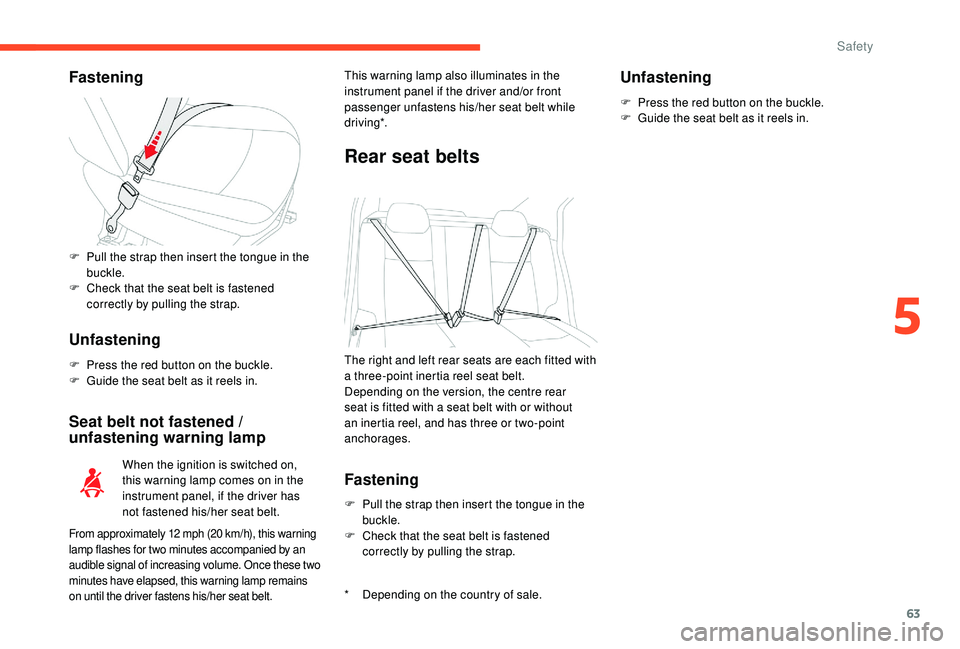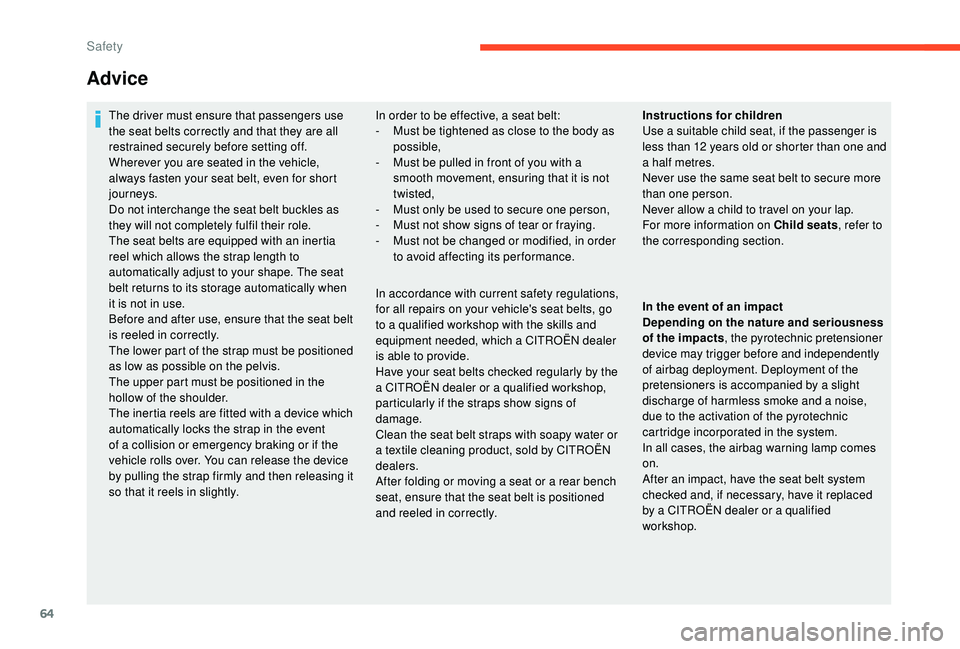warning CITROEN C-ELYSÉE 2022 Handbook (in English)
[x] Cancel search | Manufacturer: CITROEN, Model Year: 2022, Model line: C-ELYSÉE, Model: CITROEN C-ELYSÉE 2022Pages: 260, PDF Size: 8.4 MB
Page 36 of 260

34
Boot
Opening
Unlocking and releasing the boot
using the remote control
F Hold the centre button on the remote control down for more
than one second.
The boot lid is released and opens slightly.
Releasing the boot from the
inside
F Press the boot opening button located on the left of the dashboard.
The boot lid is released and opens slightly.
Opening the boot
F Raise the boot lid to its fully open position.
Closing
F Lower the boot lid using one of the interior grab handles.
F
T
hen press the boot to close it.
-
w
hen the engine is running ,
this warning lamp comes on,
accompanied by a message in
the multifunction screen for a few
seconds,
-
w
hen the vehicle is moving
(speed higher than 6
mph
(10
km/h)), this warning lamp
comes on, accompanied by an
audible signal and a message in
the multifunction screen for a few
seconds.
Back-up release
System for mechanically unlocking the boot in
the event of a battery or central locking fault.
UnlockingIf the boot lid is not fully closed:
F
F
old back the rear seats to gain access to
the lock from inside the boot.
If your vehicle is fitted with a fixed bench
seat, contact a CITROËN dealer or a
qualified workshop.
F
I
nsert a small screwdriver into hole A of the
lock to unlock the boot lid.
In the event of a fault or difficulties are
encountered on manoeuvring the boot
lid when opening or closing it, have it
checked by a CITROËN dealer or a
qualified workshop as soon as possible to
prevent this issue getting worse, causing
the boot lid to drop, and serious injuries.
Access
Page 52 of 260

50
Mats
Removable carpet protection.
Fitting
When fitting the mat for the first time, on the
driver's side use only the fixings provided in the
wallet attached.
The other mats are simply placed on the
carpet.
Removing
To remove the mat on the driver's side:
F M ove the seat as far back as possible.
F
U
nclip the fixings.
F
R
emove the mat.
Refitting
To refit the mat on the driver's side:
F P osition the mat correctly. To avoid any risk of jamming of the pedals:
-
O
nly use mats which are suited to the
fixings already present in the vehicle;
these fixings must be used.
-
D
o not fit one mat on top of another.
The use of mats not approved by
CITROËN may inter fere with access to
the pedals and hinder the operation of the
cruise control / speed limiter.
F
R
efit the fixings by pressing.
F
C
heck that the mat is secured correctly.
Storage box
F Raise the boot floor to access the storage
box.
This has areas for the storage of a box of spare
bulbs, a first aid kit, two warning triangles, etc.
It also houses the vehicle tools, the temporary
puncture repair kit, etc.
Ease of use and comfort
Page 59 of 260

57
General safety
recommendations
Labels are affixed in different locations on
your vehicle. They include safety warnings
and vehicle identification. Do not remove
them: they are an integral part of your
vehicle.
For any work on your vehicle, use a
qualified workshop that has the technical
information, skills and equipment required,
all of which a CITROËN dealer is able to
provide.We draw your attention to the following
points:
-
T
he fitting of electrical equipment
or accessories not approved by
CITROËN may cause excessive
current consumption and faults and
failures with the electrical system of
your vehicle. Contact a CITROËN
dealer for information on the range of
recommended accessories.
-
A
s a safety measure, access to
the diagnostic socket, used for the
vehicle's electronic systems, is
reser ved strictly for CITROËN dealers
or qualified workshops, equipped
with the special tools required (risk
of malfunctions of the vehicle's
electronic systems that could cause
breakdowns or serious accidents).
The manufacturer cannot be held
responsible if this advice is not
followed.
-
A
ny modification or adaptation not
intended or authorised by CITROËN
or carried out without meeting the
technical requirements defined by
the manufacturer will result in the
suspension of the legal and contractual
warranties. Installation of accessory radio
communication transmitters
Before installing a radio communication
transmitter, you must contact a CITROËN
dealer for the specification of transmitters
which can be fitted (frequency, maximum
power, aerial position, specific installation
requirements), in line with the Vehicle
Electromagnetic Compatibility Directive
(2004/104/EC).
Depending on country regulations, some
safety equipment may be compulsory:
high visibility safety vests, warning
triangles, breathalysers, spare bulbs,
spare fuses, fire extinguisher, first aid kit,
mud flaps at the rear of the vehicle, etc.
5
Safety
Page 60 of 260

58
Hazard warning lamps
F When you press this red button, all four direction indicators flash.
It can operate with the ignition off.
Automatic operation of
hazard warning lamps
When braking in an emergency, depending on
the deceleration, the hazard warning lamps
come on automatically.
They switch off automatically the first time you
accelerate.
F
Y
ou can also switch them off by pressing
the button.
Horn
Audible warning system to alert other road
users to an imminent danger.
Emergency or assistance
call
Localised Located
Emergency Call
In an emergency, press this
button for more than 2 seconds.
Pressing this button again
immediately cancels the request.
The green LED remains on (without flashing)
when communication is established.
It goes off at the end of the call.
F
P
ress the central part of the steering wheel. The flashing green LED and the voice message
confirm that the call has been made to the
"Localised Located Emergency Call" service*.
The green LED goes off.
Safety
Page 63 of 260

61
Anti-lock braking system
(ABS) and electronic brake
force distribution (EBFD)
The fixed illumination of this warning
lamp signals that there is a fault with
the ABS.
Illumination of this warning lamp,
coupled with the STOP and ABS
warning lamps, accompanied by
the display of a message and an
audible signal, signals that there is a
fault with the electronic brake force
distribution (EBFD).
Normal operation of the ABS may make
itself felt by slight vibration of the brake
pedal.
When braking in an emergency, press
firmly without ever releasing the
pressure. When changing wheels (tyres and rims),
ensure that these are approved for your
vehicle.Anti-slip regulation (ASR)
/ Dynamic stability control
(DSC)
Operation
These systems are activated automatically
every time the vehicle is started.
They come into operation in the event of a
problem of grip or trajectory.
Deactivation
In exceptional conditions (starting a vehicle
which is bogged down, stuck in snow, on soft
ground, etc.), it may be advisable to deactivate
these systems, so that the wheels can turn
freely and regain grip.
Reactivate the systems as soon as the level of
grip permits.
The vehicle retains conventional braking. Drive
carefully at moderate speed.
Contact a CITROËN dealer or a qualified
workshop as soon as possible.
You must stop as soon as it is safe to do so.
Call a CITROËN dealer or a qualified
workshop. This is indicated by this warning
lamp flashing in the instrument
panel.F
P
ress this button until the
corresponding symbol appears
in the instrument panel.
The button indicator lamp comes on.
The ASR and DSC systems will no longer have
an effect on engine operation or the brakes in
the event of an involuntary change of trajectory.
Reactivation
The ASR system is reactivated automatically
every time the ignition is switched back on or
from 30
mph (50 km/h).
Below 30
mph (50 km/h), you can reactivate it
manually.
F
P
ress this button again to
reactivate the system manually.
The button indicator lamp goes off.
5
Safety
Page 64 of 260

62
Malfunction
Illumination of this warning lamp,
accompanied by the display of a
message and an audible signal,
indicates a fault with the system.ASR / DSC
These systems offer increased safety
in normal driving, but they should not
encourage the driver to take extra risks or
drive at high speed.
It is in conditions of reduced grip (rain,
snow, black ice) that the risk of loss of grip
increases. It is therefore important for your
safety to keep these systems activated in
all conditions, and particularly in difficult
conditions.
The correct operation of these
systems depends on obser vation of
the manufacturer's recommendations
regarding the wheels (tyres and rims),
braking and electronic components and
the assembly and repair procedures used
by CITROËN dealers.
The use of snow tyres is recommended,
in order to be able to benefit from the
efficiency of these systems in winter
conditions.
In this case, it is essential to equip the
four wheels with tyres approved for your
vehicle.
Seat belts
Front seat belts
The front seat belts are fitted with a
pretensioning and force limiting system.
This system improves safety in the front
seats in the event of a front or side impact.
Depending on the severity of the impact, the
pretensioning system instantly tightens the seat
belts against the body of the occupants.
The pretensioning seat belts are active when
the ignition is on.
The force limiter reduces the pressure of
the seat belt on the passenger’s chest, thus
improving their protection.
Contact a CITROËN dealer or a qualified
workshop to have the systems checked.
Safety
Page 65 of 260

63
Fastening
Unfastening
F Press the red button on the buckle.
F G uide the seat belt as it reels in.
Seat belt not fastened /
unfastening warning lamp
* Depending on the country of sale.
F
P
ull the strap then insert the tongue in the
buckle.
F
C
heck that the seat belt is fastened
correctly by pulling the strap. This warning lamp also illuminates in the
instrument panel if the driver and/or front
passenger unfastens his/her seat belt while
driving*.
When the ignition is switched on,
this warning lamp comes on in the
instrument panel, if the driver has
not fastened his/her seat belt.
From approximately 12 mph (20 km/h), this warning
lam p flashes for two minutes accompanied by an
audible signal of increasing volume. Once these two
minutes have elapsed, this warning lamp remains
on until the driver fastens his/her seat belt.
Rear seat belts
Fastening
F Pull the strap then insert the tongue in the buckle.
F
C
heck that the seat belt is fastened
correctly by pulling the strap.
Unfastening
F Press the red button on the buckle.
F G uide the seat belt as it reels in.
The right and left rear seats are each fitted with
a three-point inertia reel seat belt.
Depending on the version, the centre rear
seat is fitted with a seat belt with or without
an inertia reel, and has three or two-point
anchorages.
5
Safety
Page 66 of 260

64
Advice
The driver must ensure that passengers use
the seat belts correctly and that they are all
restrained securely before setting off.
Wherever you are seated in the vehicle,
always fasten your seat belt, even for short
journeys.
Do not interchange the seat belt buckles as
they will not completely fulfil their role.
The seat belts are equipped with an inertia
reel which allows the strap length to
automatically adjust to your shape. The seat
belt returns to its storage automatically when
it is not in use.
Before and after use, ensure that the seat belt
is reeled in correctly.
The lower part of the strap must be positioned
as low as possible on the pelvis.
The upper part must be positioned in the
hollow of the shoulder.
The inertia reels are fitted with a device which
automatically locks the strap in the event
of a collision or emergency braking or if the
vehicle rolls over. You can release the device
by pulling the strap firmly and then releasing it
so that it reels in slightly.In order to be effective, a seat belt:
-
M ust be tightened as close to the body as
possible,
-
M
ust be pulled in front of you with a
smooth movement, ensuring that it is not
twisted,
-
M
ust only be used to secure one person,
-
M
ust not show signs of tear or fraying.
-
M
ust not be changed or modified, in order
to avoid affecting its performance. Instructions for children
Use a suitable child seat, if the passenger is
less than 12
years old or shorter than one and
a half metres.
Never use the same seat belt to secure more
than one person.
Never allow a child to travel on your lap.
For more information on Child seats , refer to
the corresponding section.
In accordance with current safety regulations,
for all repairs on your vehicle's seat belts, go
to a qualified workshop with the skills and
equipment needed, which a CITROËN dealer
is able to provide.
Have your seat belts checked regularly by the
a CITROËN dealer or a qualified workshop,
particularly if the straps show signs of
damage.
Clean the seat belt straps with soapy water or
a textile cleaning product, sold by CITROËN
dealers.
After folding or moving a seat or a rear bench
seat, ensure that the seat belt is positioned
and reeled in correctly. In the event of an impact
Depending on the nature and seriousness
of the impacts
, the pyrotechnic pretensioner
device may trigger before and independently
of airbag deployment. Deployment of the
pretensioners is accompanied by a slight
discharge of harmless smoke and a noise,
due to the activation of the pyrotechnic
cartridge incorporated in the system.
In all cases, the airbag warning lamp comes
on.
After an impact, have the seat belt system
checked and, if necessary, have it replaced
by a CITROËN dealer or a qualified
workshop.
Safety
Page 68 of 260

66
Malfunction
If this warning lamp on the
instrument panel comes on, you
must contact a CITROËN dealer
or a qualified workshop to have the
system checked. The airbags may
no longer be deployed in the event
of a serious impact.
Lateral airbags
Deployment
Malfunction
If this warning lamp on the
instrument panel comes on, you
must contact a CITROËN dealer
or a qualified workshop to have the
system checked.
The airbags may no longer be deployed in the
event of a serious impact. In the event of a minor impact or bump on
the side of the vehicle or if the vehicle rolls
over, the airbags may not be deployed.
In the event of a rear or front collision,
none of the lateral airbags are deployed.
The front airbag inflates between the thorax
and head of the front occupant of the vehicle
and the steering wheel, driver's side, and the
dashboard, passenger's side, to cushion their
for ward movement.
System that contributes towards improving the
protection of the driver and front passenger in
the event of a serious side impact, in order to
limit the risk of injury to the chest, between the
hip and the shoulder.
Each lateral airbag is fitted in the seat backrest
frame, door side. They are deployed unilaterally in the event
of a serious side impact applied to all or part
of the side impact zone B
, perpendicular to
the longitudinal centreline of the vehicle on a
horizontal plane and directed from the outside
towards the inside of the vehicle.
The lateral airbag contributes towards the
protection of the front occupant of the vehicle,
between the lower thorax and the head.
Safety
Page 72 of 260

70
Deactivating the
passenger's front airbag
Never install a "rear ward facing" child
restraint system on a seat protected by
an activated front airbag. This can cause
death or serious injury to the child.
Passenger airbag OFF
Deactivation
When the ignition is on, this warning
light comes on in the instrument
panel and stays on while the airbag
is deactivated.
To assure the safety of your child,
the passenger's front airbag must be
deactivated when you install a "rear ward
facing" child seat on the front passenger
seat. Otherwise, the child risks being
seriously injured or killed if the airbag is
deployed.
Reactivation
When you remove the "rear ward facing" child
seat, with the ignition off , turn the switch to
the ON position to reactivate the airbag and so
assure the safety of your front passenger in the
event of an impact.
The warning label, located on each side of the
passenger sun visor repeats this advice. This label is located on the middle door pillar,
passenger side. In line with current legislation, you will find this
warning in all the required languages in the
following tables.
Only the passenger's front airbag can be
deactivated.
F
W
ith the ignition off , insert the key into the
passenger airbag deactivation switch. F
T
urn it to the "OFF" position.
F
R
emove the key keeping the switch in this
position.
Safety